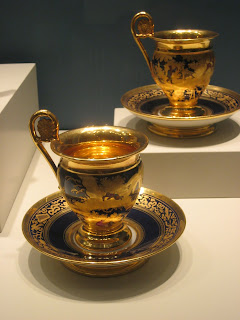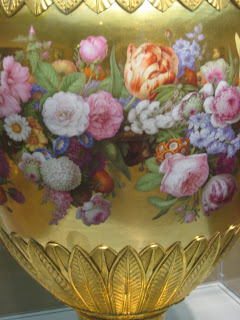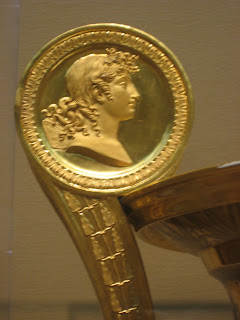Egyptian Revival Paris porcelain inkwell pastille burner
Faith was not on my side. As I spilled hot coffee on the monitor that connects my Internet. Three and a half hours before the auction would go off on this early 19th century Egyptian Revival piece of Old Paris porcelain. I thought Oh well I will just go downtown and use my laptop at a cafe to bid on this piece before the auction end. I arrive at the cafe 30 min before the auction end and was having a problem connecting my laptop to the Internet. I finely get connected but now I can't log on to the Internet, as the minutes tick away a lose this item. Latter that night my monitor dries out and my Internet is back on, this rare piece of porcelain worth $5,000. at the right show only sells for the opening bid of 85,00 euro $104.00 dollars. So goes my life. I was mad for days and I sill AM.
Side view
Rare Egyptian Revival Old Paris porcelain figure of a kneeling Egyptian woman holding a dish pastille burner {burning pastille a solid aromatic substance that was burned like incense} circa 1805 1810. This piece is a inkwell and a pastille burner, a rare combination. The Egyptian woman is semi nude with skirt, headdress and jewelry. One each side of her are shells one for ink the other sand. and above the shells attached to her side skirt are white shell shaped jars for holding the quail pen. She is on a nice round base that is painted in mat blue with neoclassical gold gilt tracery painted all around. The woman has more European features then Egyptian, you can see this in her profile making this lovely piece a French ideal of Egypt.
Back view
This type of item became popular in Europe after Napoleon Bonaparte's unsuccessful military expedition to Egypt in 1798. Napoleon a propagandist bought back Egyptian artifacts to France that resulted in an explosion of information on the country and prompted more strictly archaeological interpretations of the Egyptian Revival style in the Arts. Also this piece is attributed to the Darte-frères French porcelain manufacturer .
This elegant swan cup with saucer was made by the Darte Freres Manufactory
The Darte Freres Paris porcelain factory was started in 1801 by Louis-Joseph and Jean-Francois and quickly gained a reputation for producing beautiful hand decorated hard paste porcelain wares in the Empire and classical styles specializing in tea services, cabinet plates, and vases. The factory was not long-lived, but was a favorite and under royal protection of Emperor Napoleon’s mother. Darte-frères was appointed supplier of porcelain to the Empress Joséphine de Beauharnais. The Creole Empress Josephine kept a flock of swans at the Chateau de Malmaison, her favorite residence outside of Paris, and used their image on many of her personal possessions. Darte-frères made elegant swan shaped cups with saucers for the Empress. Darte-frères famous for "Old Paris" porcelain from 1801 to 1833.
Portrait of the Empress Joséphine




,QWBMIOmcDGig~~_12.jpg)




MukQ~~_12.jpg)

wSqh62w~~_1.jpg)































































